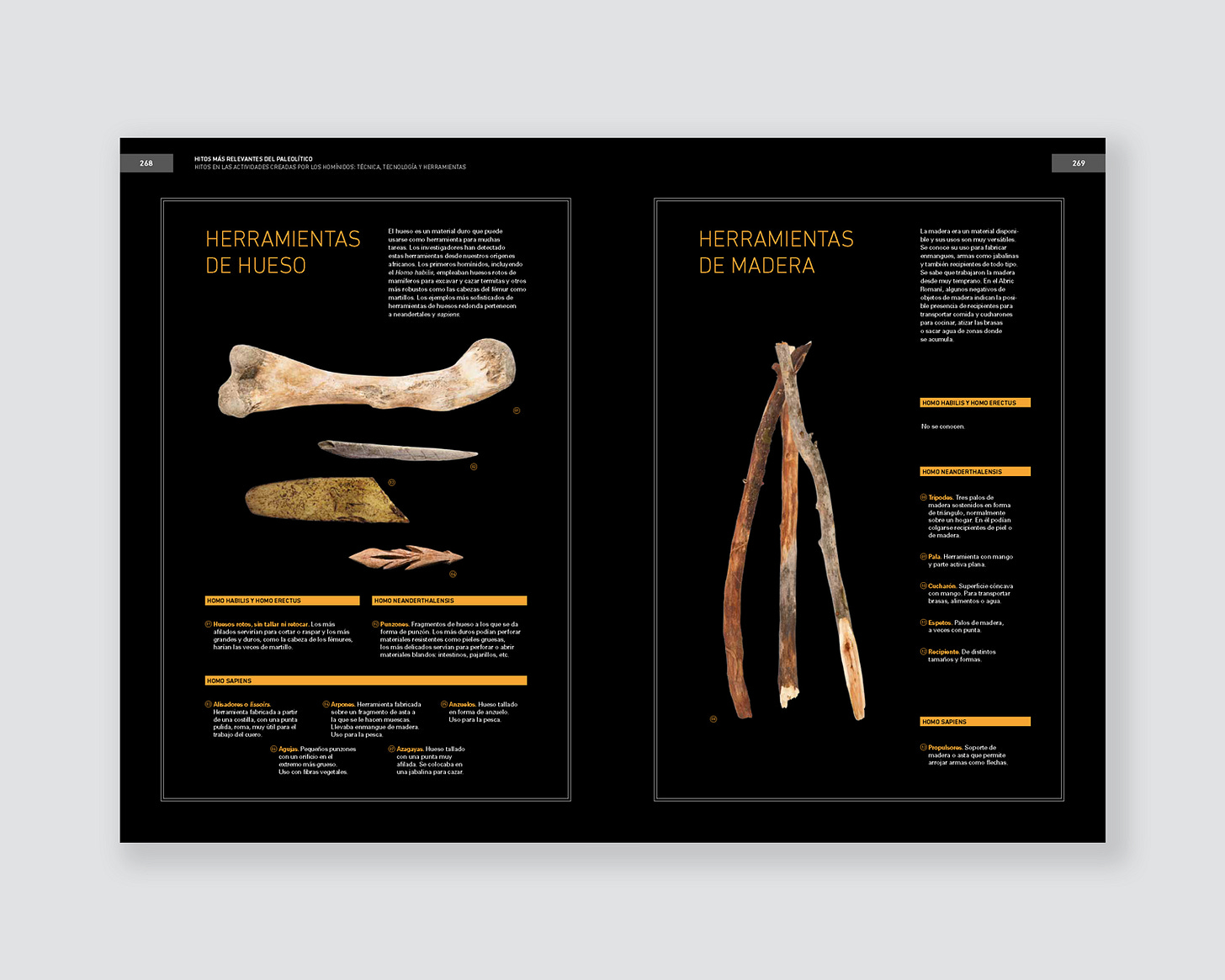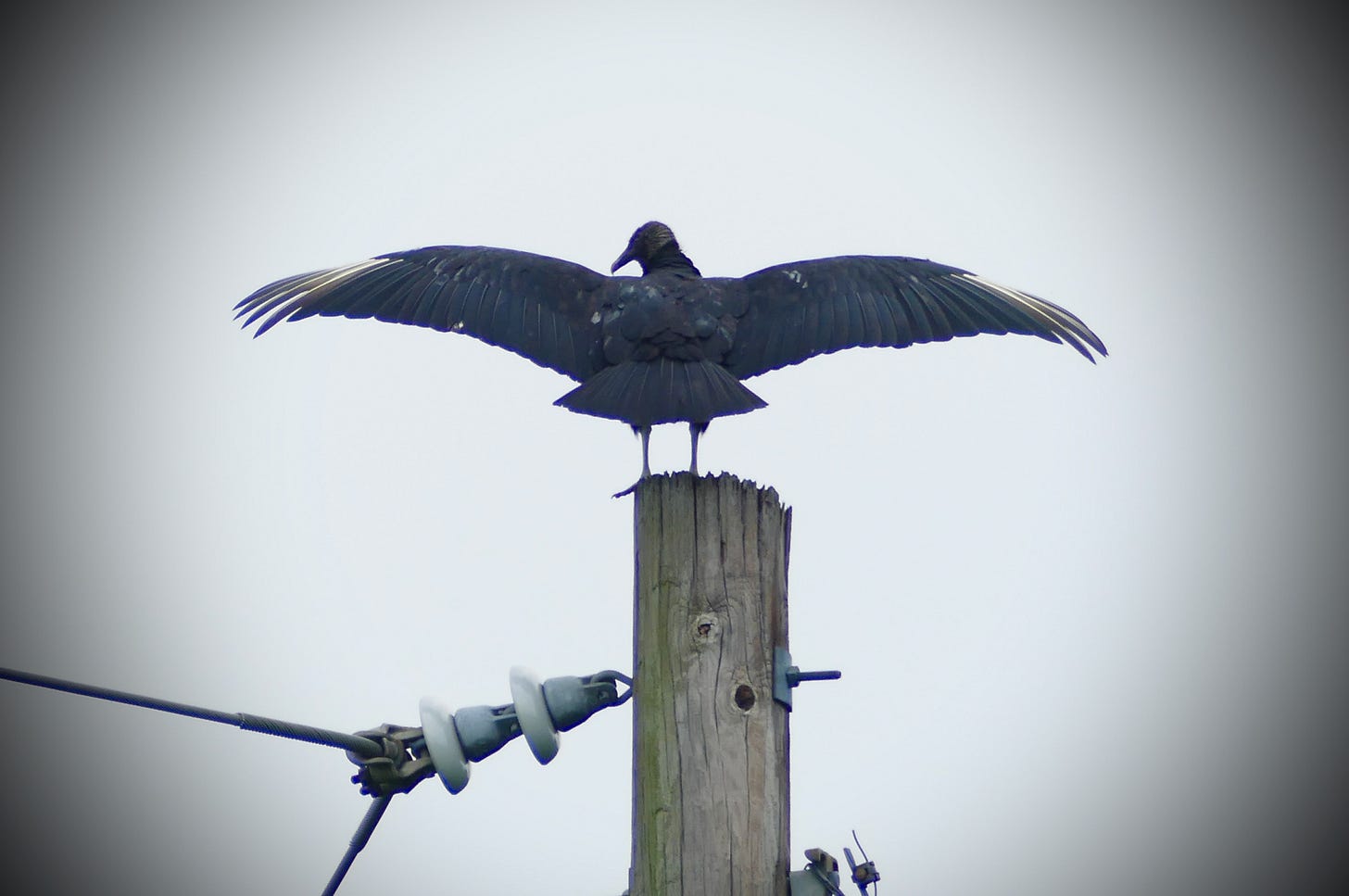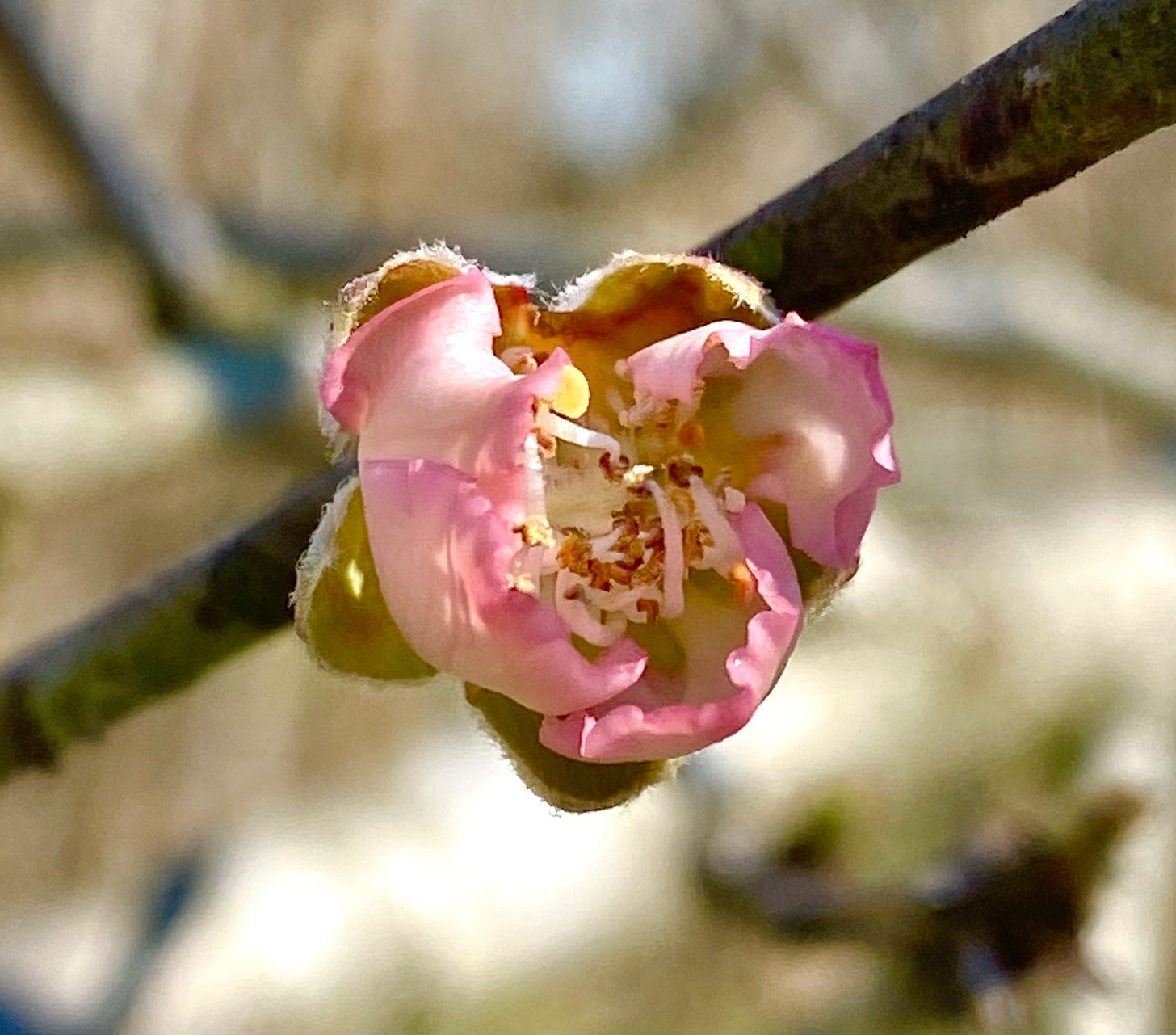Raised by vultures
Tuesday morning as I walked the dogs past the oxygen tank distributor, I came upon an urban trapper sleeping in his pickup. It was a bright red GMC Sierra stenciled with the image of a scorpion ready to strike and the logo of Research Pest Control - Live Capture and Removal. The bed was packed with traps, rolls of narrow-gauged chicken wire, a long reel of orange hose, and a few big aluminum suitcases that you probably should not open even though they are unlocked. Looking at the gear and remembering the winter weekend when I had to trap and remove a squirrel that had found its way into the cozy confines of my little house in Iowa City, I figured the guy had earned the right to nap.
He picked a good spot, under one of the tall pecans that have been there longer than the businesses below, trees that fill in the warmer months with orange-bellied whistling ducks who follow the river here from far away. They had not yet begun the daily hiss-clank pressure adjustments on the big tanks, and the big lot over the fence where he was parked is empty now, between owners, though later in the week it would be taken over by a film crew, maybe one of the ones that uses Austin as the location of the end of the world. A little further down the block was the staging area of the phone company service technicians, but they seem to have cleared out too, and in the morning light their telephone pole training yard looked like an enigmatic ruin, the ritual henge of some post-industrial pagans.
If he had parked a block to the east he might have seen the pair of hawks who nest in a big hackberry on the traffic island between two forks of the tollway onramp. That’s their refuge, there in the little pocket of woods no one but the guys who camp in such spots pays much attention to. But on quiet mornings the hawks come out to hunt from the telephone poles and street lamps, patiently waiting for the mammals of the field to sneak out of the woods, under the fences behind the factories, and make a run for it across the lanes of accelerating vehicular traffic.
We never pay much notice to telephone poles, even though they are perhaps the most common trees in the urban landscape. Trees that grew tall and straight somewhere else, killed by us and stripped to their vertical essence, treated with chemicals to delay their rot, and then re-planted in tidy rows and hung with the branches of our network infrastructure. You can’t help but think our mass manufacture of perfectly spaced lanes of dead trees has helped the North American raptors adapt to our habitat. Each pair of hawks around here seems to have its own preferred poles, between the pockets of woods that house their prey and the roadways that render their prey vulnerable.
When the hawks are done with their morning hunts, the black vultures come in to harvest the roadkill too big for the hawks to carry away.
Last Sunday afternoon when I took a break around 4 p.m., a group of them had gathered on the poles along our street. At first I just noticed the one, sitting up there above the terminus of two roads, framed by one of those right-of-way trees that has been pruned into submission to the electrical grid. Then I looked down the street and saw another pair, and then saw a bigger group in an actual tree a block away. I wondered whether they were feeding on the fresh opossum I had seen that morning in the eastbound lane, the dead cat around the corner, or the source of the fox fur I had found at the crosswalk.
The carrion crows, as Audubon called them, seem to be especially active in this season between winter and spring, when most of the migratory birds have already passed through and the summer birds haven’t yet gotten busy, as even the cardinals this year seem wary of nesting after being burned by the insane winter storm of two weeks ago. You see them cruising all through the day, flying low over the yard as they look for death in the tall grass, or flying high over the hot freeways. Sunday they came with a cold north wind that blew harder on Monday.
When you find them perched up there after a long day disemboweling the dead, they don’t seem to mind you walking up and taking their picture. Maybe because they are busy defecating on themselves to stay cool, as they do. They won’t let you get close enough to see their faces, but when you catch them through the zoom, and you really take a look at their beaks and heads, you better appreciate what they are designed for. And then you wonder where those stains came from.
They are quiet birds, having none of the organs other avian species use to sing. If you get close enough to surprise a group of them on foot or in a canoe, you will hear their hisses and grunts, and the sound of those huge wings. And if you spend enough time in their environment, you will come to see what tricksters they can be. Social vultures who can produce their own carrion in the right circumstances, very different than their more solitary cousin the turkey vulture.
Over decades of interstate driving, I came to assume that the seeming ubiquity of vultures in the American landscape was directly related to our highways and the roadkill they generate, and the way our paving of the land generates intense thermal updrafts the vultures can ride all day long. Many scientists have tested similar theories, and while there’s some correlation between the northern expansion of turkey vultures and the exploding population of white-tailed deer, the consensus seems to be that a connection with roads cannot be proved. Though one has to wonder how much can really be learned by the kind of studies that involve dropping dead rabbits in front of trailcams.
What’s more clear, especially as you read about black vultures, is that these scavengers have always thrived around our urban settlements, long before pavement and motor vehicles. Consider Audubon’s description from the 1830s:
Although shy in the woods, [the black vulture] is half domesticated in and about our cities and villages, where it finds food without the necessity of using much exertion. Charleston, Savannah, New Orleans, Natchez, and other cities, are amply provided with these birds, which may be seen flying or walking about the streets the whole day in groups. They also regularly attend the markets and shambles, to pick up the pieces of flesh thrown away by the butchers, and, when an opportunity occurs, leap from one bench to another, for the purpose of helping themselves. Hundreds of them are usually found, at all hours of the day, about the slaughterhouses, which are their favourite resort. They alight on the roofs and chimney-tops, wherever these are not guarded by spikes or pieces of glass, which, however, they frequently are, for the purpose of preventing the contamination by their ordure of the rain water, which the inhabitants of the southern States collect in tanks, or cisterns, for domestic use. They follow the carts loaded with offal or dead animals to the places in the suburbs where these are deposited, and wait the skinning of a cow or horse, when in a few hours they devour its flesh, in the company of the dogs, which are also accustomed to frequent such places. On these occasions they fight with each other, leap about and tug in all the hurry and confusion imaginable, uttering a harsh sort of hiss or runt, which may be heard at a distance of several hundred yards. Should eagles make their appearance at such a juncture, the Carrion Crows retire, and patiently wait until their betters are satisfied, but they pay little regard to the dogs. When satiated, they rise together, should the weather be fair mount high in the air, and perform various evolutions, flying in large circles, alternately plunging and rising, until they at length move off in a straight direction, or alight on the dead branches of trees, where they spread out their wings and tail to the sun or the breeze. In cold and wet weather they assemble round the chimney-tops, to receive the warmth imparted by the smoke. I never heard of their disgorging their food on such occasions, that being never done unless when they are feeding their young, or when suddenly alarmed or caught. In that case, they throw up the contents of their stomach with wonderful quickness and power.
This connection between carrion birds and human habitat has a deeper resonance when you learn, as I did this week, that the best evidence indicates that early humans first learned to eat meat by acting like vultures themselves, feasting on the carcasses left behind by the large predators of the savanna before other scavengers like hyenas got to them, and taking advantage of primitive tools to harvest parts of the carcass like bone marrow that the hyenas could not get to. This was apparently the means whereby Australopithecus grew itself 2.8 million years ago into Homo habilis, who then figured out how to cook the meat with fire, an innovation some now theorize was intended to make the carrion safer to eat. It also did much of the work other animals need to do through more extensive digestion, freeing up energy and space for brain development.
Maybe the people who tout the wonders of roadkill cuisine aren’t so crazy after all.
Various Evolutions
I read about early hominid scavenging in what you might call the ultimate paleo cookbook, which arrived in this week’s mail. The Origins of Cooking: Paleolithic and Neolithic Cooking, from the ElBullifoundation, is a Catalan chef’s deep history of human food preparation through the prism of haute cuisine, and the first in a multi-volume encyclopedia of human gastronomy. The chef behind the project is Ferran Adrià, whose El Bulli was a world-famous Michelin three-star restaurant on the Costa Brava. If you believe Wikipedia, the books subsidized the restaurant, not the other way around. It's a wonderfully nutty tome, like reading the PowerPoint presentation of some imaginary gourmand from a Wes Anderson movie.
Closer to home, Friday night we watched the new documentary Truly Texas Mexican, narrated by the San Antonio-based food writer Adán Medrano and based on his book of the same name, which began streaming on Amazon Prime this week.
Directed and shot by the Uruguayan documentarians Anibal Capoano and Gabriel Bendahan, the film is a charismatic and accessible examination of Tejana cooking through the prism of deep history, using familiar staples of our regional diet to see the indigenous heritage and ancient matriarchal traditions Anglo culture has worked hard to render invisible. It also provides a fresh reminder of how the idea of “Tex-Mex” was rooted in 20th century racism. Most interestingly for readers of this newsletter, Truly Texas Mexican does all this against a background of ecology, understanding the food’s connection to the flora and fauna of the Rio Grande borderlands and alternating contemporary cooking scenes with visits to key natural areas and archaeological sites.
Thanks to Addie Broyles at the Austin American-Statesman for this great feature that tipped us off.
This week’s mail brought the new issue of Bookforum, which featured this awesome cover photo by Harald Sund of the author Octavia Butler. The feature about Butler by Gabrielle Bellot is good, and follows an excellent piece by Ed Park in the February issue of Harper’s, both covering the new Library of America edition of Butler’s novels Kindred and Fledgling and her Collected Stories (the Harper’s piece also reviews Lynell George’s new critical work on Butler’s creative life and process, A Handful of Earth, A Handful of Sky).
Last fall Butler’s 1993 dystopian novel Parable of the Sower—an intense vision of 21st century humans navigating an increasingly hostile urban ecology—made the NYT paperback bestseller list for the first time, 14 years after she died. Having discovered Butler’s best work rather late myself, it’s great to see this mainstream literary attention to an author who didn’t get that much attention during her lifetime. It’s also sad, and makes me wonder how much our genre categories delay the widespread discovery of great books, especially from authors who are also social outsiders in their personal lives.
The Ed Park essay in Harper’s does an especially good job weaving such themes together with biographical insights and a clear-headed critical review of the collected works, providing a compelling read whether you are a Butler completist or new to her work.
Circling back to Audubon, the most surprising thing I read this week may have been this passage from the Birds of America entry on black vultures, revealing an approach to birding that Judge Glanton would approve:
The Carrion Crows of Charleston resort at night to a swampy wood across the Ashley river, about two miles from the city. I visited this roosting place in company with my friend JOHN BACHMAN, approaching it by a close thicket of undergrowth, tangled with vines and briars. When nearly under the trees on which the birds were roosted, we found the ground destitute of vegetation, and covered with ordure and feathers, mixed with the broken branches of the trees. The stench was horrible. The trees were completely covered with birds, from the trunk to the very tips of the branches. They were quite unconcerned; but, having determined to send them the contents of our guns, and firing at the same instant, we saw most of them fly off, hissing, grunting, disgorging, and looking down on their dead companions as if desirous of devouring them. We kept up a brisk fusilade for several minutes, when they all flew off to a great distance high in the air; but as we retired, we observed them gradually descending and settling on the same trees. The piece of ground was about two acres in extent, and the number of Vultures we estimated at several thousands. During very wet weather, they not unfrequently remain the whole day on the roost; but when it is fine, they reach the city every morning by the first glimpse of day.
Despite all these signs of the Hell we made, spring began to actually show its face this week, on trees that two weeks ago were coated in thick ice.
Have a great week.












Good morning, and thank you so much for the note and review of our film "Truly Texas Mexican." You've captured the notes of the film so well, particularly the history and the difficult issues of racism, erasure, tex-mex. From our production team, thank you. Adán Medrano
Fascinating read! Thanks.